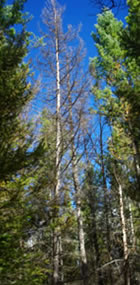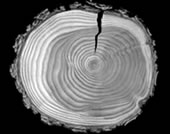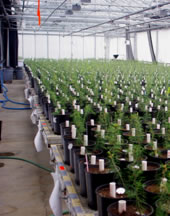
Douglas-fir trees killed by Phellinus root disease.
Douglas-fir is one of Canada’s most highly valued trees, not only because it covers a wide range of ecosystems, but also because of its high-quality products. Douglas-fir is processed into lumber, veneer products, interior and exterior finishing, and pulp.
However, Douglas-fir faces a number of biological and climate-related stresses, including Armillaria and Phellinus root diseases, Douglas-fir beetle and drought. These stresses can either kill the trees or affect the way they grow over the long term, and in turn affect the upstream value chain, where buyers and processors rely on consistent quality in the wood.
Canadian Forest Service (CFS) scientists are investigating the occurrence of natural stress resistance and desirable wood quality traits in Douglas-fir.

Distorted tree stem ring growth caused by Armillaria root disease affects timber product value and yield.
In partnership with the British Columbia Ministry of Forests, Lands and Natural Resource Operations, the researchers initially studied the effects of Armillaria root disease on tree survival, growth and product value. The results showed that many of the best-surviving trees had good growth before infection, but suffered the highest growth impact after infection. Other trees showed little or no root disease-caused effect on their growth but infection did result in higher damage and mortality from the disease. These findings, which suggest that trees able to halt the fungus (i.e., limit damage) do so at a cost to their growth, have significant implications, since growth rate determines tree ring widths, which affect both the quality and quantity of wood products. The results are being incorporated into stand simulators that can predict the yield and value of Douglas-fir at a variety of stand ages.

Greenhouse study of multiple stress agents.
The CFS is now working to identify trees that are both good survivors and good growers, with desirable shape and wood properties, even when exposed to multiple stresses. A combination of disease-tolerance or disease-resistance traits could maximize both survival and growth, and ultimately improve the value of timber products. The process for identifying naturally occurring beneficial traits in Douglas-fir could then be applied to other tree species. For forest managers, this means considering disease tolerance and resistance, in addition to tree height and volume, in multiple trait selection. The goal is to prevent timber harvest losses, declines in wood quality and increase stability of stands to stress.
Contact: Mike Cruickshank, CFS
A note about third-party information
Information provided by external sources is subject to change at any time. The Government of Canada is not responsible for the accuracy, reliability or timeliness of the information supplied by external sources. If you plan to rely upon this information, you should consult directly with the source of information. Content provided by external sources is not subject to official languages, privacy or accessibility requirements.